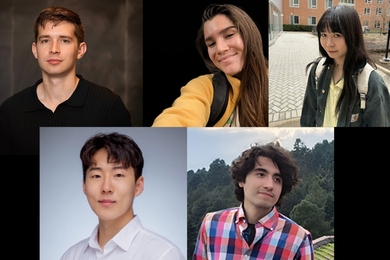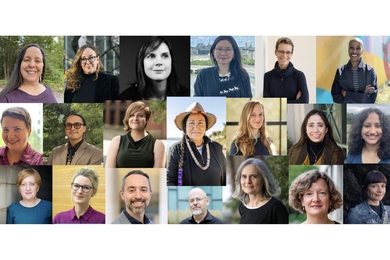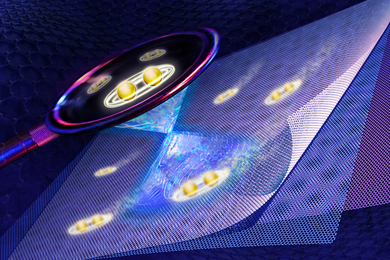Economist and Institute Professor Emeritus Robert M. Solow and Kenneth N. Stevens, the Clarence J. LeBel Professor of Electrical Engineering, are among this year's recipients of the National Medal of Science. President Clinton on Monday named 12 of the nation's most respected researchers, three of them Nobel Prize winners, to receive the 1999 awards.
Nobel laureate Solow will receive his medal in economics. Professor Stevens will receive a medal in engineering for his research in speech sciences that laid the groundwork for many of today's speech synthesis and recognition technologies.
"It was surprise, partly because I'm in a field that normally doesn't receive that kind of recognition," Professor Stevens said. "It was gratifying for the field, in a sense, and meaningful in terms of my career and in terms of great colleagues and students I've had here.
"MIT has been a great place to work in this field. I've brought together engineers with scientists in linguistics and psychology because speech covers quite a wide area."
Congress established the Medal of Science, administered by the National Science Foundation, in 1959. There have now been 374 medals bestowed on leading US scientists and engineers.
This year's recipients are a diverse group that created new scientific fields such as conservation biology and speech sciences and led to discoveries that determined why the ozone hole exists, among other things.
"The contributions of these scientists are so profound, so connected to our everyday lives and so lasting that these medals go only a short way to express the gratitude the nation owes them," said Rita Colwell, director of the National Science Foundation (NSF).
The new medalists will receive their medals along with five awardees of the National Medal of Technology, which were also announced Monday, on March 14 at the White House.
In addition to Professors Solow and Stevens, two former members of the MIT faculty and two MIT alumni were awarded National Medals. David Baltimore, Nobel laureate, professor of biology and president of the California Institute of Technology, was recognized for "far-reaching, fundamental discoveries that dramatically altered field of study in virology, molecular biology and immunology, for excellence in building scientific institutions, and in fostering communication between scientists and the general public." He was a former Institute Professor at MIT.
John Ross, professor of chemistry at Stanford University, was cited for his enormous impact in physical chemistry, especially in molecular studies, statistical mechanics, nonlinear kinetics, and for opening up new fields in chemical science. Ray Kurzweil (SB 1970), chairman and CEO of Kurzweil Technologies, Inc., received a National Medal of Technology for "pioneering and innovative achievements in computer science such as voice recognition which have overcome many barriers and enriched the lives of disabled persons and all Americans." The late Robert Swanson, former chairman of K&E Management, Ltd. who received MIT bachelor's and master's degrees in 1970, received a posthumous National Medal of Technology for his contribution in establishing and developing the biotechnology industry.
Other medal recipients include chemist Stuart A. Rice; physicists James W. Cronin and Leo P. Kadanoff from the University of Chicago; Susan Solomon, a senior scientist at the National Oceanic and Atmospheric Administration (NOAA) in Boulder, Colo.; Jared Diamond, physiology professor at the UCLA School of Medicine; Lynn Margulis, a University of Massachusetts distinguished professor; Felix E. Browder of Rutgers University ;and Ronald R. Coifman at Yale University.
ROBERT SOLOW
Professor Solow holds bachelor's, master's and doctoral degrees in economics from Harvard University. He created the modern framework for analyzing the effects of investment and technological progress on economic growth, which has greatly influenced economics and economic policy worldwide.
Professor Solow showed how to separately measure the growth of the economy among increases in the labor supply, capital stock and improved technological possibilities. The analysis showed the critical importance of technological advances for economic growth, an importance considerably larger than had been stressed before.
His work also revolutionized research in much of economics, including statistical processes of inequality, the effects of taxation, the level of the national debt, the design of institutions in developing countries, the use of both renewable and nonrenewable resources, the determination of exchange rates, and the effects of monetary policy. Subjects previously studied separately and without adequate dynamics are now studied in an integrated fashion with attention to dynamic and long-term consequences. For this contribution, Professor Solow was awarded the Nobel Prize in Economics in 1987.
KENNETH STEVENS
How people move the tongue, lips and other articulators fast enough to accomplish speech is one of the classical puzzles of speech science. Professor Stevens, who is affiliated with the Research Laboratory of Electronics, has shown that many of the distinctions between speech sounds utilize special nonlinear relations between articulation and acoustic output that enable speakers to produce correct sounds without having to hit all of the individual articulator targets with particular accuracy. In this way, he has unraveled an important part of the mystery that shrouds our ability to produce and understand speech.
Professor Stevens, who received the ScD in electrical engineering from MIT and bachelor's and master's degrees in engineering physics from the University of Toronto, has pioneered contributions to the theory, mathematical methods and analysis of acoustics in speech production.
His theoretical work on acoustic properties of speech sounds that comprise the linguistic elements of language has led to the contemporary foundations of speech science. His theoretical work on acoustic invariance has defined unifying principles that have integrated major portions of acoustic phonetics, phonology, speech science and linguistics.
A version of this article appeared in MIT Tech Talk on February 2, 2000.





